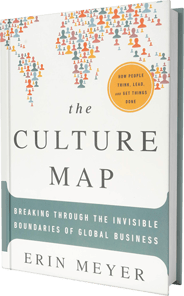At first glance, it may seem like the supply chain would be one of the biggest challenges facing a global AV systems integrator. But the reality is that navigating global workplace cultural diversity is far more complex and multifaceted.
It’s true that the analog of human nature and workplace culture has always been challenging. But when you add all the factors associated with geographic differences to the pressures of meeting deadlines, making decisions, or giving feedback – especially in a hybrid world – it’s easy even if the “words” are correct for meaning to be misunderstood – sometimes the intent truly gets lost in translation.
Mapping Culture, Improving Communication
As CEO of GPA (a global AV/UC integrator with a presence in over 50 countries), I work daily with all manner of people worldwide, which has driven a deep curiosity about local, regional, and global cultures and how this affects my own team’s success, and indeed that of our customers.
 |
One of the most powerful resources I’ve come across to date in understanding why sometimes simply understanding another person’s “words” is not enough is Erin Meyer’s exceptional book, The Culture Map: Breaking Through the Invisible Boundaries of Global Business. In it, Meyers shares eight key scales on which cultures can differ, and in turn, undermine how we might interact and collaborate. |
The 8 scales are summarized as follows:
- Communicating: low-context vs. high-context
- Evaluating: direct negative feedback vs. indirect negative feedback \
- Persuading: principles-first vs. applications-first
- Leading: egalitarian vs. hierarchical
- Deciding: consensual vs. top-down
- Trusting: task-based vs. relationship-based
- Disagreeing: confrontational vs. avoids confrontation
- Scheduling: linear-time vs. flexible-time
Simply understanding these scales and the inherent differences in how individuals from different countries are likely to approach each given the unrecognized cultural biases we all tend to have, can help culturally diverse teams drastically improve their effectiveness. It offers a tangible tool to analyze the positioning of one culture relative to another, helping one avoid misguided assumptions of why a peer may be acting or communicating the way they are to thereby better decode the meaning of some of their actions and gestures.
How Cultural Differences Play Out in the Global Workplace
Most of us have been in professional situations where we’ve had to “read the room” to gauge what to say or how to respond. But reading the room is more challenging when using Microsoft Teams or Zoom and even harder when working across geographic boundaries.
Here’s an example of how this might play out:
In a low-context culture like the United States, a meeting facilitator may quickly move on to a new item on the agenda if nobody raises their hand or jumps in with a question. In contrast, individuals from high-context cultures like Japan may rely more on visual cues such as looking down at the table if nothing is left to say or looking up and making eye contact waiting to be invited to speak when they have something to contribute. Failing to understand this dynamic may result not only in lost opportunity to gain a peer’s input but potentially create offence and lack of any future contribution.
This is but one example of how a lack of cultural awareness has the capacity to create misunderstanding, multicultural team friction, and misalignment, and ultimately undermine the foundations of the collaboration we are trying to empower.
A Real-World Example of Culture-Based Frictions
| GPA was founded 15 years ago (2008), and with our unparalleled geographical footprint, we’ve had plenty of direct experience with how cultural differences impact success. | 
|
Here’s one real-world example:
When implementing AV solutions in Latin America, most hardware is in fact exported from Miami, and thereby subject to a variety of complex variables including shipping, currency fluctuation, importation costs, and general bureaucratic inefficiency. The time and cost associated with managing these complexities often causes frustration not only for our customers, but even our own regional teams.
A recent multi-million-dollar, multi-country opportunity in Latin America created frustration as we navigated justification and explanation of these complexities between the various American and Latin American stakeholders involved – regions the culture map illustrates have polar differences in terms of approach to the likes of Communicating, Disagreeing, and Trust.
Questions, concerns, and misunderstandings abounded until we had a total reset and drew in a recognized GPA “cultural bridge” resource to help facilitate. This exercise clearly addresses the inherent unconscious cultural biases and perceptions each of the various stakeholders might have, allowing all sides to recognize there was not, in fact, any lack of trust or respect from the other parties. The session helped everyone voice their concerns and re-focused the team on collaboration. Transparent documentation was created as a result. In addition, all involved increased their cultural understanding and awareness, and our GPA team members increased trust among themselves and with the customer. This enhanced the customer’s confidence in our overall organizational expertise and ability to support them within the complexities of global delivery.
While this is just one example, we know from experience these struggles happen every day within our teams, and indeed we know within our customers’ organizations.
GPA’s Approach to Cultural Challenges
At GPA, we are committed to building intentional processes that help us work as a team no matter the geographical diversity to those within it. So important has this premise of Cultural “mindfulness” become within GPA, the premises behind the “Culture Map” has now become a cornerstone of our organization. From development of practical tools, to testing our processes and templates against these premises, to identification of “Cultural Bridges” – individuals with heightened understanding and skillsets in cultural diversity ready to help support their peers in overcoming or avoiding culture-driven conflicts – we continue to look for ways to embrace and embed “Cultural Awareness” as a foundation to all we do and how we do it.
I believe this is a foundational differentiator for GPA and plays a daily role in creating GPA’s “unfair” advantage - for ourselves, and ultimately in the role we play in helping power our customer's objectives to achieve a similar advantage among their competitors.
Building Intentional Processes, Reducing Communication Challenges
As leaders in an ever more global economy, it is our responsibility to create awareness and education among our teams on the important role culture plays in communicating with one another. While the way we deliver is through the maturity of our approaches to global program management, scaled and innovative managed services, etc., these can only work if they are built upon a foundation of people-centric core values. While I’m happy with our results to date, I know that exceeding our global customers’ expectations is ongoing work, but I know as long as cultural awareness and understanding are at the forefront that our team is equipped for that challenge.
Editor's Note: Byron Tarry is Managing Director and CEO of AVI’s engine for global delivery, GPA. For more information on how we can help you better deliver on any global technology program you may be considering, visit www.thinkgpa.com.









